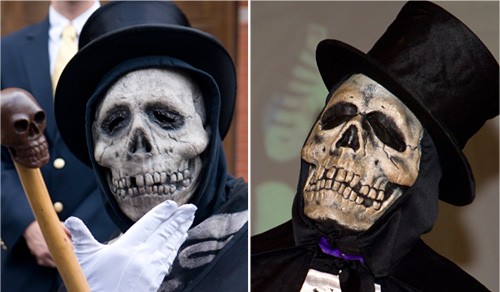Summer 2009: Of Note

double trouble: Left, Oxford’s Dooley; right, Emory’s.
Kay Hinton
Dueling Dooleys
By Breanna McDaniel 09OX 11C and Nina Dutton 11C
From time to time, on both the University’s main campus and its Oxford campus, the indomitable spirit of Emory takes human form to walk amongst mortals. But each campus’s incarnation of Dooley has a distinct personality.
The tale of two Dooleys springs from a common source at Oxford, Emory’s first campus. The University’s unofficial, rather morbid mascot made his first appearances in 1899 and 1909 by writing letters to the student publication the Emory Phoenix, according to Gary Hauk, vice president and deputy to the president. From his afterlife in a science laboratory, Dooley wrote letters featuring observations on students, faculty, and society.
Lord James W. Dooley, who takes his first name and middle initial from the current University president, is represented on each campus by a student—whose identity is kept secret—dressed as a skeleton with a black cape, a black top hat, and white gloves, surrounded by bodyguards in black clothes and dark shades. While the main-campus Dooley strolls upright, black cane in hand, the Oxford manifestation creeps around, relying on a bent wooden cane—topped with a brown skull—for support.
“While they look alike and have similar characteristics, they are completely different entities; both have evolved along different paths from the same source,” says Joseph Moon, Oxford’s dean of campus life.
The crouched, mysterious Oxford Dooley contrasts with the more genteel, yet carefree, Dooley at the Atlanta campus, according to Assistant Director of the Office of Student Leadership and Service Tanya Willard, who wrote her master’s thesis on Dooley.
“Oxford’s Dooley is slightly rougher around the edges. He’s definitely not as polished as the Dooley on the main campus,” Willard says.
When Dooley appears at Oxford, his original home, the focus is usually on what he might have to say to the students through his spokesperson. On a campus of 753 students, the seemingly omniscient Dooley is always up to date with—and ready to pass judgment on—the latest community news.
Oxford sophomore Emilomo Akharume 10OX is president of Oxford’s social club Dooley’s Dolls. “I remember last year when he came and he praised an Oxford student for being a positive spirit on campus,” Akharume says. “It’s just great to see your fellow classmates get praised for being themselves and doing something that they may not think is out of the ordinary.”
But when Oxford’s Williams Hall was vandalized in the 2008 spring semester, Dooley posted a letter asking students to take responsibility for their actions and called out some suspected vandals, members of the on-campus social club Sigma Gamma, by their names.
“Common experiences and traditions help to build community, so Dooley definitely enlivens—no pun intended—the Oxford community,” Moon says.
Hauk agrees that Dooley’s role as the cloaked campus critic is stronger at Oxford, where he “has been more of a throwback, or more consistent with the earlier tradition of Dooley as a commentator on the specifics of life on campus.”
Though the main-campus Dooley is also known for his statements on current University affairs, he tends to be more energetic, approaching death with a sense of whimsy—as evidenced by the “Soulja Boy” dance Dooley performed with orientation leaders at SongFest in 2007, Willard recalls. The lively dance performance also demonstrated Dooley’s changing nature.
The Oxford and main-campus personalities of Dooley seem to have switched places over time.
“Even in the time when I first started here, the Dooley at Oxford was really playful and had a lot of personality, and the one here was very slow-moving and rigid and didn’t have a lot of personality,” says Willard, who began working at Emory in 2000.
But both Dooleys stand with one foot in the present and one set of metatarsals firmly planted in the past.
“He embodies a lot of the history at Emory,” Willard says. “But he has fairly successfully changed with the times.”
This article by Breanna McDaniel 09OX 11C and Nina Dutton 11C originally appeared in the Emory Wheel.